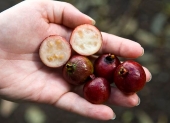Hey Kärlis, I have a very stupid answer to your question: It all depends on the specific conditions of your site! Annual rainfall, length of dry season, lowlands or elevated location, sandy soil or clay, acidic or alkaline soil, existing fertility...you get the idea. I would recommend that you study which plants actualy thrive near the location (e.g. what is growing at the roadside over there?).
So all my suggestions below may or may not work for you.
A)
-Acacia mangium. I observed that only the most shittiest conditions are barely good enough for this tree...even everything is dry as hell, but it keeps growing and growing.
-Leucaena (if the soil is not too acid); Since it may become invasive, you may not want to be the first person introducing it to the region. It is a common roadside weed, so you can find it easily if present.
-Neem tree
B)
-pigeon pea (drought resistant)
-Tephrosia candida (drought resistant)
-Bananas (only possivble if some fertilizer input is available); Their mulch is very helpful, because full of water.
C) Other stuff (yes, you didnt asked for it

-cow pea (annual)
-If you have grassland, you may just want to regularly cut it and organize the mulch in areas where you start growing stuff. The trick with tropical grasses is to cut them before they become monsters.
Of course, this is just a tiny fraction of possibilities, others will surely add more.






 ). On my land in Thailand (4 rai = 6400 sqm) this specie surely starts to outcompete other plants - its very shade tolerant, grows fast and tall, and the new shaded area of an established tree becomes the breeding ground for at least another tree and bit by bit this plant conquers more area. Well, in my case (due to the small property size) I simply start cutting the trees. The foliage makes good mulch, and I use the wood for making biochar.
). On my land in Thailand (4 rai = 6400 sqm) this specie surely starts to outcompete other plants - its very shade tolerant, grows fast and tall, and the new shaded area of an established tree becomes the breeding ground for at least another tree and bit by bit this plant conquers more area. Well, in my case (due to the small property size) I simply start cutting the trees. The foliage makes good mulch, and I use the wood for making biochar.
